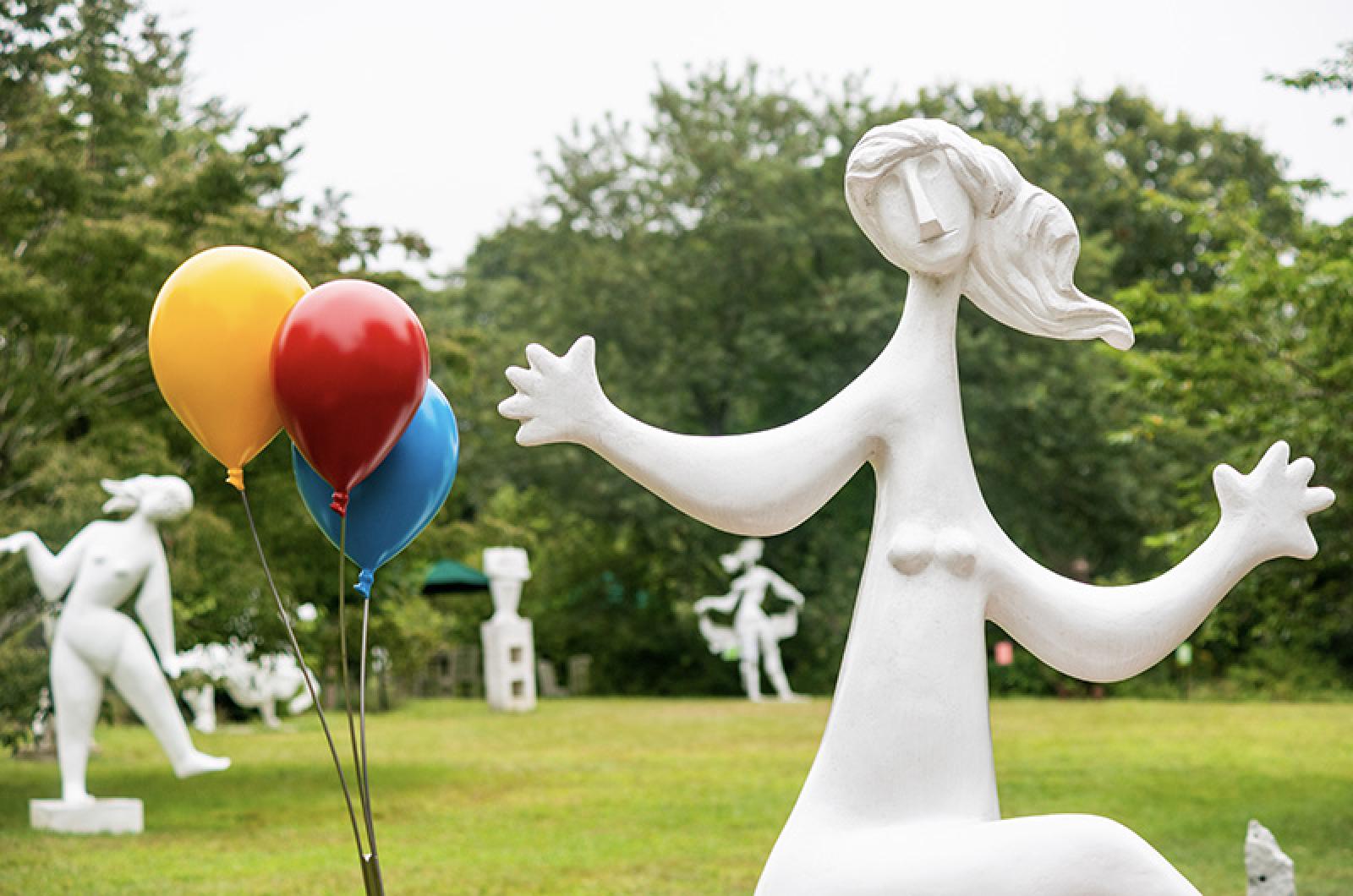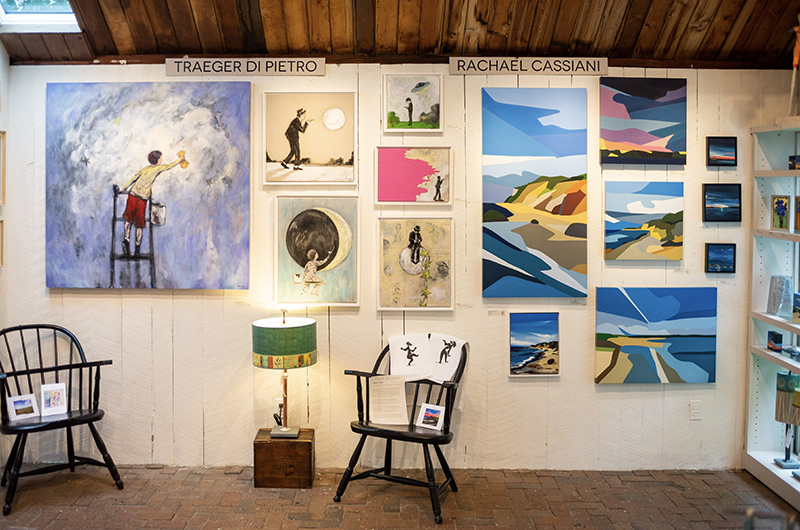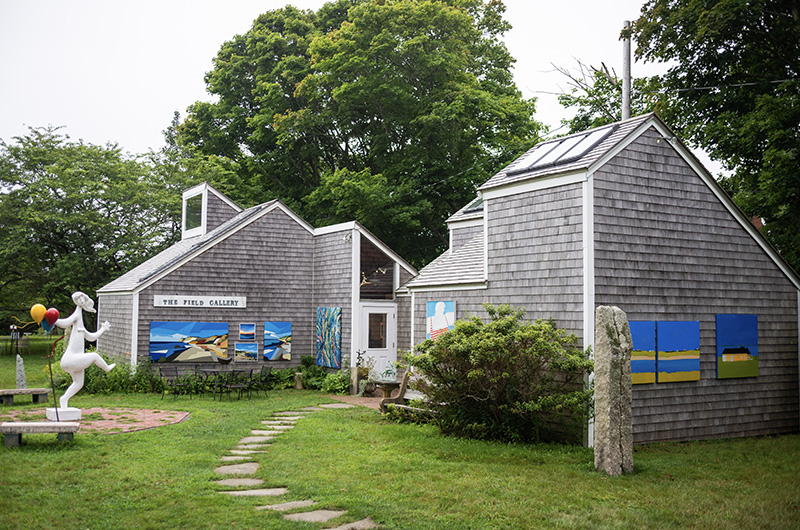In 1975, West Tisbury resi dents lamented the potential disappearance of an essential element of the town’s whimsical soul.
“West Tisbury is going to be denuded of its nudes,” a Gazette article from February of that year forewarned. “The Bacchanalian figures that dance in the meadow next to the Field Gallery are going to take up permanent residence in Boston. Tom Maley, the sculptor responsible for the figures, said this week that he sold six of them to Alan Tremain of Boston and that two more, the largest ones in the field, may go too.”
The concerns never came to pass. While Mr. Tremain’s trendy Back Bay restaurant— aptly named “The Whimsies”— did acquire some of Mr. Maley’s iconic statues, the town has never, thankfully, been “denuded of its nudes.”
Mr. Maley founded the gallery in 1971 in the field behind his family’s home with fellow artists Robert Schwartz, Eleanor Coen and Max Kahn. The construction of the gray, shingled gallery building required two summers and the labor of family and friends.
The gallery is now owned by Chris Morse and his wife Sheila, who also own the Granary and North Water Galleries.
“It’s the only art gallery on the Vineyard that was built to be an art gallery,” Mr. Morse said.
Last Sunday, August 8, the gallery marked its 50th anniversary on the exact date that the founders celebrated its opening in 1971.
“In a field opposite the church in West Tisbury artists have built a gallery to show their work and to serve the community as a center for education,” the 1971 invitation stated. “You are invited to join us in our opening party.”
Construction of the gallery began in 1970 but wasn’t completed until the following year.
“Work on the gallery will have to wait until all the free labor gets out of school,” Mr. Maley wrote in a letter between the summers of ’70 and ’71, his daughter, Eileen Maley, shared in her essay, “How the Sculpture Dance Began.”
The youth of the building crew imbued themselves into the essence of the building — literally. Mr. Schwartz’s 14 year-old son, William, installed the electrical wiring. Despite any concerns about the crew’s inexperience, their craftsmanship has stood the test of time.
“We’ve changed nothing except for a coat of paint and a new window here and there,” Jennifer Pillsworth, director of the gallery, said.
Unlike his son, Mr. Schwartz, the building’s architect, was a trained professional.
Sunday’s celebration remembered these origins fondly. Guests dined on ham and cheese sandwiches and lemonade, the staple lunch of the original construction crew.
“Doing it during the day was important to me, instead of a cocktail thing,” Ms. Pillsworth said of the event. “I think
this place is about families and kids running around. We had a sprinkler out here and kids were running through that — that feels more true to the roots of what they originally were thinking than wine and cheese.”
Presenting art in an accessible and fun manner has always been at the core of the gallery’s vision.
“So many art galleries are stuffy or they can feel stuffy, and art can feel overwhelming, like scary expensive,” Ms. Pillsworth said. “[The Maleys] were never about that, and so I want to make sure that we aren’t either.”
Its location on State Road allows passersby to easily stroll in and wander about the garden. On any given summer day, countless families snap photos in front of the statues, curving and outstretching their arms to match the figures’ poses. Mr. Morse was one of those children decades ago.
“I knew the gallery when I was a little kid,” he said. “I have pictures of me holding my grandmother’s hand when I was 10 years old in front of the sculptures there.”
In 2001, Mr. Morse and his wife bought the Field Gallery from the Maley family following Tom’s death the previous year. The Maleys retained ownership of the land at the time.
“Our goal is never to change it,” Mr. Morse said. “We always wanted to complement and build on the successes that the Maley family had started.”
Still, despite these personal convictions, Field Gallery loyalists wanted assurance the new owner wouldn’t mess with their beloved institution.
“When my wife and I first bought the gallery, local artist Stan Murphy, had [us] over for a drink, and the reason for having us over was sort of to interview us to make sure we weren’t going to do anything to insult the integrity of the town of West Tisbury or upset the charm that the gallery has reflected,” Mr. Morse said. “I certainly assured him that wouldn’t happen, and I think he was pleased.”
Ms. Pillsworth joined the gallery in 2003. She felt her and Mr. Morse’s task at that time was to maintain the original focus while also keeping the gallery fresh and in-step with the changing art world. She says they achieved this by bringing in more abstract and nonrepresentational art.
“The Field has really found its voice as a contemporary art gallery,” she said.
In 2011, the town of West Tisbury purchased the land and building from the Maleys, while Mr. Morse continues to operate the gallery space inside.
In the 1990 book, Tom Maley Sculpture, Mr. Maley sketched his hopes for the gallery.
“The original plan for the gallery,” he wrote, “was to house our own works. But to sustain interesting and varied exhibits all season would not be possible, so the building became a gallery for other artists who wished to exhibit. We also hoped, without any profit to ourselves, to benefit the Island in as many ways as possible. Aside from a gallery to exhibit works of art, the surrounding field is more used for plays, dance recitals, weddings, early morning yoga classes, political speeches, and even Easter egg hunts— a nice place to eat your lunch.”
Walking among the garden’s shady trees and alabaster sculptures on Wednesday, Ms. Pillsworth commented on the symbiotic relationship between the gallery and the rest of downtown.
“7a doesn’t have a lot of places to sit, so everybody comes here to eat their lunch,” she said.










Comments (1)
Comments
Comment policy »